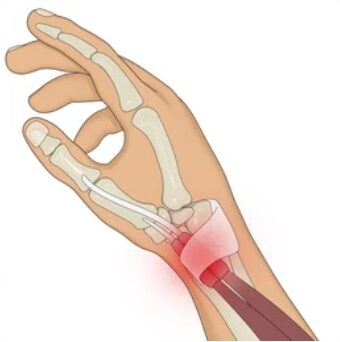
Understanding De Quervain’s Tenosynovitis: A Specialist’s Insight
De Quervain’s Tenosynovitis is a painful condition affecting the tendons on the thumb side of your wrist. If you have De Quervain’s Tenosynovitis, it will likely hurt when you turn your wrist, grasp anything, or make a fist.
Symptoms
- Pain near the base of your thumb
- Swelling near the base of your thumb
- Difficulty moving your thumb and wrist when you’re doing something that involves grasping or pinching
- A sticking or stop-and-go sensation in your thumb when moving it
The pain might appear suddenly or gradually. It can travel into your thumb or up your forearm. Repetitive activities and overuse are commonly associated with this condition.
Causes
The exact cause of De Quervain’s Tenosynovitis isn’t known, but any activity that relies on repetitive hand or wrist movement can make it worse. This includes:
- Playing golf or racket sports
- Lifting your baby or toddler repeatedly
- Working in the garden
Diagnosis
Diagnosis is based on the physical examination. Your doctor may ask you to perform the Finkelstein test, which involves bending your thumb across your palm and bending your fingers down over your thumb, then bending your wrist toward your little finger. If this causes pain, De Quervain’s Tenosynovitis is likely.
Treatment
Non-Surgical Treatment
- Splints: Wearing a splint to rest your thumb and wrist
- Medications: Anti-inflammatory medications like ibuprofen to reduce swelling and pain
- Physical Therapy: Stretching and strengthening exercises
- Steroid Injections: Corticosteroid injections to reduce inflammation and pain
Surgical Treatment
If your symptoms are severe or don’t improve with non-surgical treatments, your doctor may recommend surgery. The procedure, known as De Quervain’s release, involves opening the sheath that surrounds the inflamed tendons to release pressure and allow free tendon movement.
Surgery Steps:
- Incision: A small incision is made over the inflamed tendons.
- Sheath Opening: The tendon sheath is carefully opened to release the tendons.
- Closing the Incision: The incision is closed with stitches, and a bandage is applied.
The procedure is usually done under local anesthesia, and it’s typically an outpatient surgery. Recovery includes a brief period of immobilization followed by physical therapy to restore strength and flexibility.
Recovery and Outlook
Post-surgery, patients may need to wear a splint for a few weeks. Physical therapy is crucial to regain strength and motion. Most patients experience significant pain relief and improved function after the procedure.
Prevention
To prevent De Quervain’s Tenosynovitis, avoid repetitive thumb and wrist movements, use ergonomic tools and techniques, and take frequent breaks to rest your hands and wrists.




